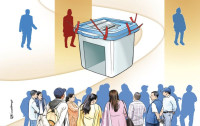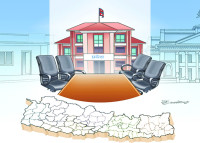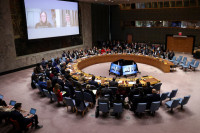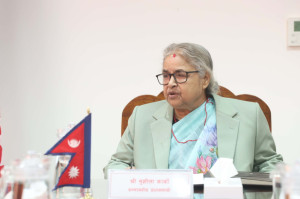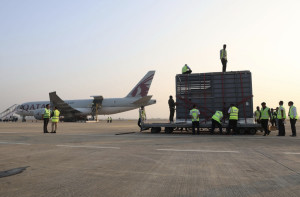Columns
Focus on fiscal fundamentals
Nepal’s current economic crisis can be solved only with bold fiscal policy measures.
Achyut Wagle
Since the appointment of Prakash Sharan Mahat as finance minister, top officials of Nepal Rastra Bank have been asserting that the Finance Ministry as the fiscal authority and the central bank as the monetary authority have been working in a better tandem. Minister Mahat also appeared to be striving to strike a balance while appointing three economic advisors at the ministry. Bishwa Paudel and Poshraj Pandey are macroeconomists, and Gunakar Bhatta is a sitting executive director at the central bank’s Regulation Department. In a country where policymaking is invariably marred by political divisions, this indeed is a laudable gesture as the government is working on formulating an “optimistic” budget for the next fiscal year amidst the most testing times in Nepal’s economic history.
But the rhetorics of Finance Minister Mahat and central bank Governor Maha Prasad Adhikari do not appear to converge. The blame game, whether it was the failure of the fiscal or the monetary policy that brought the economy to its current recessionary state, continues unabated. Finance Ministry mandarins point to the inability of the monetary authority to contain inflation and high interest rates which created a vicious cycle of low investment, low employment and a shrunken growth rate. The central bank sees the government’s blatant negligence in undertaking capital expenditure as the main problem.
Capital expenditure
Almost 10 months into the fiscal year, total capital expenditure has barely reached 32 percent of the capital budget of Rs380 billion. This undoubtedly disrupted the cashflow in the financial system and contributed to the rise in interest rates to an unfeasible level of 17-18 percent. As a result of the high interest rates, even potential small investors became more inclined to deposit money in banks for safer returns than embark on entrepreneurship in a risky environment. During the first six months of the current fiscal year, the banking sector experienced lack of loanable funds. The liquidity situation has eased with about Rs100 billion available in the market, but there are no takers due to the high cost of funds.
The economy is currently facing the twin adverse impacts of empty public coffers and slumped demand mainly due to the counterproductive and restrictive policies adopted in the past. For example, last April the government published a gazette notice banning the import of dozens of “luxury goods” under 10 headings. The ban lasted 10 months and had a telling impact on revenue collection as the import duty on luxury items is higher compared to others. As at the end of almost 10 months of the fiscal year, only 52 percent out of the Rs1,400 billion revenue target for this financial year had been realised. Even after the ban was lifted two months ago, imports did not resume through formal channels as the new smuggling routes that had opened in the porous border during the embargo continued to operate. Therefore, revenue collection did not improve, and the government account is in deficit to the tune of Rs283 billion.
The governor of the central bank has repeatedly contended that the ban prevented the Nepali economy from reeling into a crisis like in Sri Lanka. But the figures do not show that the restrictions were effective. The foreign exchange reserve rose slightly from $9.61 billion at the start of the ban to $10.69 billion in mid-March 2023. This marginal increase was more a result of a rise in remittance than the import ban. In another development, the Finance Ministry paradoxically issued a 14-point guideline for a 20 percent expenditure reduction on January 17, 2023 when capital expenditure was already so slow. Without spending, growth will not happen. In nutshell, several restrictive policies of the recent past have done harm to the economy by simultaneously reducing productive economic activities, consumption and state revenue. Self-congratulatory narratives cannot hide the damage done to the economy and it should not be the excuse for the next round of similar counterproductive measures.
Focus on fiscal policy
The importance of central bank independence and monetary policy efficacy can hardly be overemphasised to protect the financial architecture from systemic risk and the hawkishness of the political leadership which emerges often. But the federal legislature and policymaking circles must acknowledge that the current crisis can only be solved by issuing bold fiscal policy measures rather than by tweaking the monetary policy. Therefore, fiscal policy should not be swayed by the temptation to adopt a contractionary monetary policy, particularly when macroeconomic instability looms so large.
From the perspective of public financial management too, these are certainly unusually difficult times for the Nepali economy. Negative growth for the last three consecutive quarters, pressure on revenue and suboptimal capital spending even at subnational levels all indicate a herculean challenge for the fiscal policy now being drafted. However, Nepal has a comfortable fiscal cushion of a moderate level of public debt that is hovering over 40 percent of the national gross domestic product (GDP). The government must utilise it at this critical moment.
This could be an opportune moment to lean on Keynesian wisdom to generate a fiscal multiplier by increasing government spending for consumption, investment and government expenditures. Perhaps helicopter money has become indispensable to generate momentum for a stagnated economy that is staring at imminent stagflation.




 5.14°C Kathmandu
5.14°C Kathmandu
